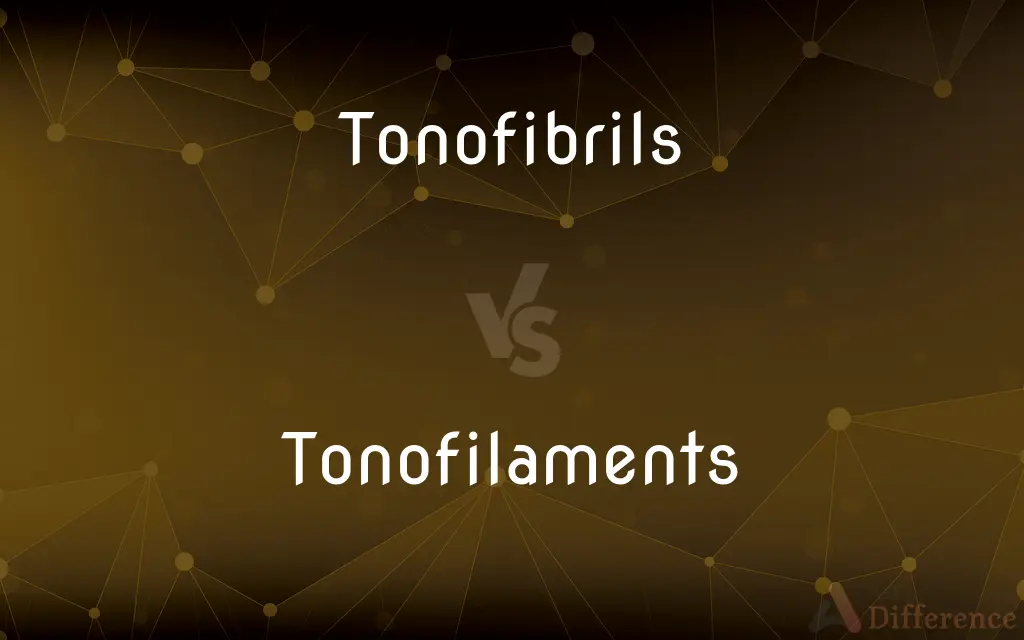Tonofibrils vs. Tonofilaments — What's the Difference?
By Tayyaba Rehman & Fiza Rafique — Published on February 7, 2024
Tonofibrils are bundles of tonofilaments in cells, providing structural support; tonofilaments are individual filamentous proteins within these bundles.

Difference Between Tonofibrils and Tonofilaments
Table of Contents
ADVERTISEMENT
Key Differences
Tonofibrils are complex structures within cells, consisting of bundled networks of tonofilaments, which contribute to the cell's structural integrity and resilience. Tonofilaments, on the other hand, are the individual filamentous proteins that make up these larger bundles. Together, they play a crucial role in maintaining the mechanical stability of cells, particularly in epithelial tissues where they are most abundantly found.
In the context of cellular anatomy, tonofibrils refer to the larger, organized bundles of filaments that are visible under a microscope, while tonofilaments are the finer, thread-like components that constitute these bundles. Tonofibrils serve as a major component of the cytoskeleton in epithelial cells, providing tensile strength and flexibility, whereas tonofilaments, composed of proteins like keratin, are the building blocks of these larger structures.
The distinction between tonofibrils and tonofilaments becomes particularly important in the study of cell biology and pathology. Tonofibrils are indicative of the cell's structural organization, and their presence can be a marker of cell differentiation and health. Tonofilaments, being the fundamental units, are crucial for understanding the molecular composition and the mechanical properties of cells.
Tonofibrils play a pivotal role in the formation of desmosomes and hemidesmosomes, structures that facilitate cell-cell and cell-matrix adhesion, respectively. Tonofilaments, by forming the core of tonofibrils, directly contribute to these adhesion processes, highlighting their importance in tissue cohesion and integrity.
Understanding the relationship between tonofibrils and tonofilaments is key to grasping the complexities of cellular structure and function. While tonofibrils represent the macroscopic manifestation of cell strength and resilience, tonofilaments provide the microscopic foundation for this robustness, underscoring the interdependence of these cellular components.
ADVERTISEMENT
Comparison Chart
Definition
Bundles of filamentous proteins in cells
Individual filamentous proteins within cells
Structural Role
Provide structural support and stability
Fundamental units of larger fibril structures
Composition
Composed of multiple tonofilaments
Made up of proteins like keratin
Visibility
Visible under light microscopy
Typically require electron microscopy for visualization
Function
Contribute to cell's mechanical strength and integrity
Form the building blocks of tonofibrils
Compare with Definitions
Tonofibrils
Contributors to the mechanical properties of cells.
The elasticity of epithelial tissues is partly due to the tonofibrils they contain.
Tonofilaments
Constituents of the cell's cytoskeleton.
Tonofilaments contribute to the structural framework within the cell.
Tonofibrils
Protein aggregates essential for cellular integrity.
Tonofibrils are crucial for maintaining the shape and resilience of skin cells.
Tonofilaments
Involved in cellular mechanical stability.
The mechanical resilience of cells is attributed to the network of tonofilaments.
Tonofibrils
Key components in the cytoskeleton of epithelial cells.
The presence of tonofibrils is a hallmark of well-differentiated epithelial tissues.
Tonofilaments
Building blocks of tonofibrils.
Each tonofibril is composed of numerous intertwined tonofilaments.
Tonofibrils
Involved in cell adhesion processes.
Tonofibrils link to desmosomes, facilitating cellular adhesion in epithelial layers.
Tonofilaments
Key in the formation of cellular junctions.
Tonofilaments anchor cells to each other and to the extracellular matrix, ensuring tissue integrity.
Tonofibrils
Intracellular structures composed of bundled tonofilaments.
The tonofibrils in the epithelial cells provide them with the necessary structural support.
Tonofilaments
Fundamental protein filaments in cells.
Keratin tonofilaments are essential for the strength of hair and nails.
Tonofibrils
Plural of tonofibril
Tonofilaments
Plural of tonofilament
Common Curiosities
How do tonofibrils contribute to cellular function?
Tonofibrils play a crucial role in maintaining the structural integrity of cells and are involved in adhesion processes.
Where are tonofibrils found?
Tonofibrils are predominantly found in epithelial cells, where they contribute to the cell's mechanical strength.
What are tonofibrils?
Tonofibrils are bundles of tonofilaments found in cells, providing structural support and stability.
What are tonofilaments?
Tonofilaments are individual filamentous proteins that make up the larger structures known as tonofibrils.
Do tonofibrils have a role in disease?
Abnormalities in tonofibrils and tonofilaments can be associated with various diseases, especially those affecting the skin and epithelial tissues.
What is the main function of tonofilaments?
The main function of tonofilaments is to serve as the building blocks for tonofibrils, aiding in cellular structure and integrity.
Can the presence of tonofibrils indicate cell health?
Yes, the presence and organization of tonofibrils can be indicative of cell differentiation and health.
How are tonofibrils involved in cell adhesion?
Tonofibrils are connected to cell adhesion structures like desmosomes, facilitating cohesion within tissues.
Are tonofibrils unique to epithelial cells?
While particularly prominent in epithelial cells, tonofibrils can also be found in various other cell types.
Can tonofibrils and tonofilaments be used as biomarkers?
In certain contexts, the presence or absence of tonofibrils and tonofilaments can serve as biomarkers for specific cellular conditions or diseases.
How do tonofibrils and tonofilaments relate to the cytoskeleton?
Both are integral components of the cytoskeleton, contributing to the cell's structural framework and mechanical properties.
What proteins make up tonofilaments?
Tonofilaments are often composed of keratin, among other filamentous proteins.
Are tonofilaments visible under a light microscope?
Tonofilaments are typically too fine to be seen under a light microscope and usually require electron microscopy for visualization.
What is the difference in visualization of tonofibrils and tonofilaments?
Tonofibrils can be observed under light microscopy, while tonofilaments often require more advanced techniques like electron microscopy.
How do tonofilaments contribute to tissue integrity?
By forming tonofibrils, tonofilaments provide a structural basis for tissue strength and resilience.
Share Your Discovery

Previous Comparison
iPad vs. Tablet
Next Comparison
Olive Oil vs. Pomace OilAuthor Spotlight
Written by
Tayyaba RehmanTayyaba Rehman is a distinguished writer, currently serving as a primary contributor to askdifference.com. As a researcher in semantics and etymology, Tayyaba's passion for the complexity of languages and their distinctions has found a perfect home on the platform. Tayyaba delves into the intricacies of language, distinguishing between commonly confused words and phrases, thereby providing clarity for readers worldwide.
Co-written by
Fiza RafiqueFiza Rafique is a skilled content writer at AskDifference.com, where she meticulously refines and enhances written pieces. Drawing from her vast editorial expertise, Fiza ensures clarity, accuracy, and precision in every article. Passionate about language, she continually seeks to elevate the quality of content for readers worldwide.
















































